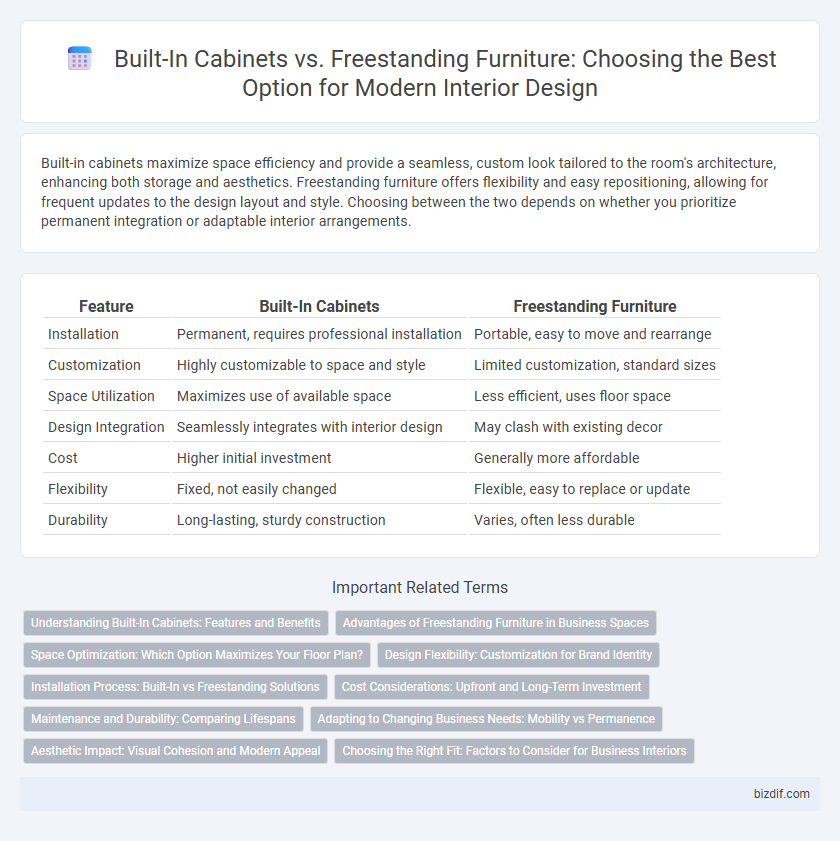Built-in cabinets maximize space efficiency and provide a seamless, custom look tailored to the room's architecture, enhancing both storage and aesthetics. Freestanding furniture offers flexibility and easy repositioning, allowing for frequent updates to the design layout and style. Choosing between the two depends on whether you prioritize permanent integration or adaptable interior arrangements.
Table of Comparison
| Feature | Built-In Cabinets | Freestanding Furniture |
|---|---|---|
| Installation | Permanent, requires professional installation | Portable, easy to move and rearrange |
| Customization | Highly customizable to space and style | Limited customization, standard sizes |
| Space Utilization | Maximizes use of available space | Less efficient, uses floor space |
| Design Integration | Seamlessly integrates with interior design | May clash with existing decor |
| Cost | Higher initial investment | Generally more affordable |
| Flexibility | Fixed, not easily changed | Flexible, easy to replace or update |
| Durability | Long-lasting, sturdy construction | Varies, often less durable |
Understanding Built-In Cabinets: Features and Benefits
Built-in cabinets offer seamless integration with interior architecture, maximizing space efficiency and providing a customized storage solution tailored to specific room dimensions. Their fixed installation enhances durability and stability, while maintaining a cohesive aesthetic by matching wall finishes or design themes. These cabinets increase property value by contributing to a polished, permanent fixture that combines utility with visual appeal.
Advantages of Freestanding Furniture in Business Spaces
Freestanding furniture offers unparalleled flexibility in business spaces, allowing easy rearrangement to accommodate changing layouts and functions without structural modifications. It provides cost-effective installation and replacement options, minimizing downtime and disruption during office reconfigurations or expansions. The variety of styles and materials available enhances customization, enabling interior designers to align furnishings with brand identity and aesthetic preferences.
Space Optimization: Which Option Maximizes Your Floor Plan?
Built-in cabinets maximize floor space by seamlessly integrating storage into walls, eliminating gaps and offering customized dimensions tailored to room layouts. Freestanding furniture provides flexibility and easy rearrangement but consumes more floor area due to necessary clearance around pieces. For optimal space efficiency, especially in small or irregularly shaped rooms, built-in solutions typically enhance overall floor plan utility and create a streamlined aesthetic.
Design Flexibility: Customization for Brand Identity
Built-in cabinets offer unparalleled design flexibility, allowing for seamless customization that reflects a brand's unique identity through tailored dimensions, materials, and finishes. Freestanding furniture provides mobility and adaptability, but often lacks the cohesive integration and personalized detailing essential for distinct brand expression. Choosing built-ins ensures a unified aesthetic that enhances spatial efficiency and reinforces brand storytelling.
Installation Process: Built-In vs Freestanding Solutions
Built-in cabinets require professional installation, involving precise measurements, wall anchoring, and integration with existing architecture, ensuring a seamless and secure fit. Freestanding furniture offers a simpler installation process, typically requiring minimal assembly and no permanent attachment to walls. The choice between built-in and freestanding solutions significantly affects installation time, cost, and flexibility in interior design layouts.
Cost Considerations: Upfront and Long-Term Investment
Built-in cabinets typically require a higher upfront investment due to custom measurements and installation costs, but offer long-term value through durability and increased home resale appeal. Freestanding furniture tends to be more affordable initially and provides flexibility for relocation or style changes, though it may incur replacement costs and less impact on property value. Evaluating both options involves balancing immediate budget constraints with potential long-term financial benefits and maintenance expenses.
Maintenance and Durability: Comparing Lifespans
Built-in cabinets typically offer superior durability due to their fixed installation and high-quality materials, often lasting 20 to 30 years with minimal maintenance. Freestanding furniture, while more versatile, commonly requires more frequent upkeep and may have a shorter lifespan of 10 to 15 years depending on the material and usage. Proper maintenance routines such as regular cleaning, polishing, and avoiding moisture exposure significantly extend the life of both built-in and freestanding storage solutions.
Adapting to Changing Business Needs: Mobility vs Permanence
Built-in cabinets offer permanence and tailored storage solutions ideal for businesses requiring a fixed layout to optimize space efficiency and brand consistency. Freestanding furniture provides mobility and flexibility, allowing companies to quickly adapt office configurations in response to evolving workflows or seasonal demands. Selecting between built-in and freestanding options depends on balancing long-term stability with the need for agile interior design in dynamic business environments.
Aesthetic Impact: Visual Cohesion and Modern Appeal
Built-in cabinets create a seamless, integrated look that enhances visual cohesion and offers a sleek, modern appeal ideal for contemporary interiors. Freestanding furniture allows flexibility and personal expression but may disrupt the flow of a space, making it less uniform in appearance. Choosing built-ins supports a minimalist aesthetic, boosting perceived room size and elevating architectural integrity.
Choosing the Right Fit: Factors to Consider for Business Interiors
Built-in cabinets maximize space efficiency and provide a seamless, custom look ideal for professional environments with specific storage needs, while freestanding furniture offers flexibility and ease of rearrangement for dynamic office layouts. Business interiors should consider factors such as space utilization, functionality, design consistency, and future scalability when choosing between these options. Assessing the workflow and aesthetic requirements ensures the selected furniture supports both operational efficiency and brand identity.
Built-In Cabinets vs Freestanding Furniture Infographic

 bizdif.com
bizdif.com